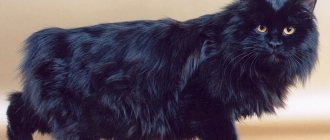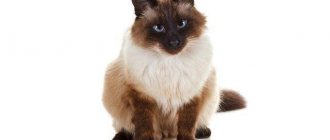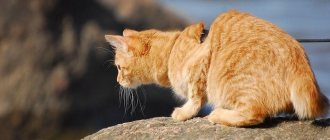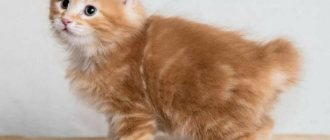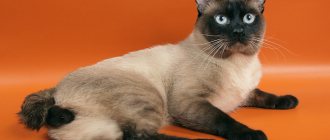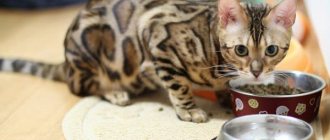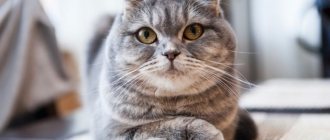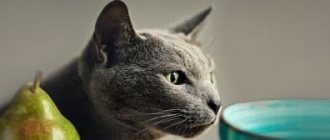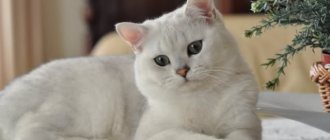There are hundreds and thousands of different cat breeds in the world, some have thick fur, some have long ears, others have no fur at all.
Such diversity leads to the fact that people are completely lost in the abyss of ignorance in matters of proper care and nutrition for both small kittens and adult cats. The topic of our article today will concern the preparation of the correct diet for kittens of the Kuril Bobtail breed.
Drinking regime
Regardless of the type of food - industrial or natural, it is important to maintain a drinking regime. The kitten's water needs to be changed every day. The Kurilian Bobtail drinks less than 250 ml of water per day. It is especially important to ensure sufficient water intake if your pet eats only dry products.
If a kitten drinks little water, you should find out the reasons for this phenomenon. Your baby may not like the bowl of liquid or the quality of the water. Insufficient fluid intake can lead to the development of a number of diseases of the digestive and urinary system in an adult cat.
So, if you chose Dry food...
We do not advise you to buy cheap dry food, as they have a low content of natural ingredients. Once you have brought your kitten into your home, the best option is to continue feeding it the same food that the breeder fed it to avoid any possible upsets due to a sudden change in food. In the future, you can choose food for him at your discretion, but definitely not lower than premium class. Do not suddenly transfer the kitten to another table. Add new food gradually and monitor the animal's reaction.
Never feed your bobtail or any other cat a mixture of dry food from different manufacturers, as this can lead to various kinds of allergic reactions, calcium-phosphorus imbalance, etc. The only thing we can afford is to add a handful to the food food (from the same manufacturer) to remove hair from the cat’s body. Removing hair from the body is a cat’s natural need. During the period of seasonal molting (spring, autumn), this need becomes higher than usual. It happens that a cat can’t cope and needs help. To do this, pet stores sell food or special “treats” for removing hair for cats. However, do not forget that food tolerance is individual for each individual cat.
Dry food should be freely available; do not pour too much into the bowl, as the food dries out and loses its attractiveness. Only if you leave the house for the whole day can you add more. The Kurilian Bobtail eats little by little, but often and, as a rule, does not overeat.
Choosing a place and dishes for feeding a kitten
The choice of place and utensils for feeding plays an important role, at least in the first days of life in a new home. Until the kitten has adapted, you need to make sure that while eating, he feels comfortable and safe.
If you have other pets in your home, feed the newbie separately.
When choosing bowls, you need to consider the following factors:
- The material from which the bowls are made.
- Width (bowl diameter).
- Depth.
According to the experience of the owners, it is better to purchase bowls made of stainless steel or ceramics. When eating, the cat's whiskers should not rest against the sides, so the diameter of the bowl should be 1.5–2 times larger than the diameter of the muzzle. The depth of the bowl depends on the purpose. Almost flat bowls are needed for food, and deep ones for water.
General information about adaptation and diet
Finding the right food for a Kurilian Bobtail kitten is as difficult as climbing Everest. This issue must be approached with all possible care, because any mistake can turn into a disaster.
We invite you to familiarize yourself with: Pixie-bob cat. Description, features, care and price of a pixie bob cat
It is worth saying that representatives of this breed are quite demanding in terms of nutrition, let alone small fluffy balls. For kittens, there is generally a whole list (on several sheets) of various taboos and restrictions. They relate to both the timing of meals and its composition.
The first thing you need to do after purchasing a little miracle is to find out from the seller what food was the basis of the baby’s diet. Since quite often kittens refuse the food that was offered in their new home.
If the adaptation period went well, is it worth immediately switching the baby to solid food?
Cat food
Eating dry pads and fresh meat or fish at the same meal will provoke pathologies of the gastrointestinal tract.
Only the highest quality food is suitable for the hunting breed - Royal Canin, Orijen, Pro Plan or Hill's. You can buy dry rations or wet canned food, but such meals should not be frequent. Nutritious dry mixtures from the economic line are strictly prohibited, as they can lead to allergies, pathology of the gastrointestinal tract and kidney failure. Whiskas and Kitty Kats are especially dangerous.
Sample menu by age
Turkey fillet can be given to your pet raw after preliminary grinding.
The most healthy products include low-fat varieties - meat from cows, bulls, young sheep, turkey or chicken. The sirloin should be finely chopped and served raw. By-products that are recommended to be given after cold treatment are also useful. Cow tripe is rich in vitamin complex and microorganisms, which improves the functioning of the gastrointestinal tract. It is also recommended to include beef liver that has undergone heat treatment in the diet, but no more than once every 4 days.
We invite you to familiarize yourself with: A cat with a flattened muzzle and big eyes
Small kittens up to 10 months are given boiled meat products, crushed to a mushy state. Daily feeding of meat to bobtails at a young age is contraindicated and can cause disruption of the functioning of the gastrointestinal tract. Kids eat liver, but it should be given in doses. Pork and lard are strictly prohibited.
Kurilian Bobtails eat 2 to 5 times a day. This figure directly depends on age. Babies up to 2 months eat more often; during this period they need to eat up to 4-5 times a day. By six months, the pet is gradually transferred to three feedings a day, and by a year - to twice a day.
We offer an overview of a sample menu by age for kittens and adolescents of the Kuril Bobtail.
Up to a month
Until the age of one month, the baby must be with his mother at all times. Bobtails begin to be fed at 3 weeks. To do this, use raw, pre-frozen and very finely chopped meat; turkey and rabbit meat are best suited.
Also, as a first complementary food, you can use low-fat cottage cheese without sugar and other additives harmful to the bobtail. The main rule is that food for one-month-old babies should be very soft.
1 month
At 1 month, the kitten continues to eat mother's milk, but also begins to eat other foods more actively. The basis of the diet is meat.
- A small Kurilian bobtail is given up to 50 grams of this product per day.
- The pet is also offered cottage cheese, yogurt, bifidok, fermented baked milk and other fermented milk products in the amount of 10-15 grams per day.
2 months
At 2 months, the Kuril Bobtail menu expands slightly. A pet eats up to 150-180 grams of food per day.
The menu consists of the following products:
- Meat (rabbit, turkey, veal, etc.) – up to 60 gr.
- Fermented milk products – up to 80 g.
- Cereals – up to 40 grams in finished form.
- Vegetables – up to 20 gr.
At this age, the pet begins to be introduced to vegetables and cereals. They are added to the bowl little by little so that the stomach gets used to the new type of food.
3 months
At this age, small Kuril Bobtails begin to go to new families. Their diet at 3 months consists entirely of
- meat and offal (up to 60-70 grams);
- cottage cheese and other fermented milk products (up to 70 g);
- cereals (up to 50 g boiled);
- vegetables (up to 30 g).
At this age, children begin to be introduced to fish. It is given to the bobtail only in boiled form, and it is better to give preference to marine species. The bones from the fish must be removed, as a small kitten can easily choke.
4-6 months
At this age, the small pet eats all the foods that adult Kuril Bobtails also eat. The total amount of food per day is 250-280 grams, and the number of feedings is reduced to three.
At 4-6 months, the kitten should receive:
- meat and offal – up to 100 g;
- cottage cheese and other fermented milk products – up to 120 g;
- fish – up to 60 g (no more than 2 times a week);
- cereals and porridges in water – up to 70 g;
- vegetables – up to 40 g;
- egg yolk – 1 pc. in Week.
ATTENTION! At this age, the pet begins to be offered a chicken egg. It can be replaced with quail eggs in a ratio of 1 to 6. This product is given to the Kurilian Bobtail no more than 1-2 times a week.
At this age, the pet has already reached its maximum size. Its diet is practically no different from the menu of adult Kuril Bobtails. A medium-sized kitten should receive up to 230 grams of food or 3-5% of its weight per day.
Origin story
How exactly the Kuril Bobtail breed appeared is still unknown. These cats first appeared on the Kuril Islands (hence the name) as a result of natural crossing of Japanese bobtails and Russian Siberian cats, which were brought to the islands by Russian merchants and fishermen. These agile animals with pom-pom tails have adapted well to the harsh climate: they have learned to excel at catching fish and rodents. Sometimes unusual cats were brought to the “mainland” as living souvenirs, but they became seriously interested in the breed only in the late 80s of the twentieth century.
Initially, felinologists did not distinguish between Japanese and Kuril bobtails, but later they noticed that the body structure, head shape and coat were significantly different from their Japanese relatives. In 1991, Moscow breeder Olga Mironova developed a breed standard, which was approved by the Soviet Feline Federation. And in 1994, the new breed was officially the world's specialists. Now there are more than a hundred Kuril Bobtail nurseries all over the world: loyal cats with an unusual appearance quickly won the love and respect of their owners.
What else do you need to know?
For breeding, it is better to contact a nursery, where they can check both the pet itself for breed, health, and its mating partner.
Among the genotypes, the tail-helix gene is considered the most stable.
If a pet with a stump tail is crossed with a longer-tailed partner, the offspring will be short-tailed.
Experts say that crossing bobtails, even from different islands, can lead to offspring that differ from the standard.
Be sure to read:
The Selkirk Rex breed is a mixture of Persian, Exotic and British, a cat with a peaceful character, description
Allergy to wool
Kurilian Bobtail
Kurilian Bobtails with long hair can cause an allergic reaction. Allergies are less common in cats with short hair.
Shedding
Long hair needs to be brushed a couple of times a week to prevent it from getting tangled. If your cat sheds constantly, this may be due to a lack of calcium in the body. The animal should be shown to a veterinarian.
The first molt occurs in the Kurobob at 6 months. An older cat, as expected, sheds twice a year.
Training
Kurilian Bobtails are smart pets . The mother usually accustoms the kittens to the litter box. As for the scratching post, pets get used to it quickly. You need to bring the kitten to it a couple of times and run its paw over the place where you need to sharpen its claws.
Kurilian Bobtails are smart pets
Bobtails are often compared to dogs in terms of intelligence and trainability. They are able to perform the “Fetch” command and bring a ball or toy. They understand prohibiting commands very well. The first command a cat is taught is “Come to me.”
Tail docking
The tail of Kurobobs is not docked.
The cat has its characteristic spring appearance with a short tail from birth. In semi-longhaired varieties, the tail looks like a pom-pom above the croup.
Vitamins and supplements in a kitten's diet
If you feed your kitten natural products, you need to introduce vitamins and supplements into the diet. Natural vitamin supplements for:
- Meat and bone meal.
- Fish, chicken, beef liver.
- Greens, vegetables, fruits.
- Sunflower oil, olive oil.
- Brewer's yeast.
- Soft, boiled cartilage.
Pharmacy vitamin supplements:
- Fish fat.
- Feed tricalcium phosphate.
- Omega-3, Omega-6.
- B vitamins.
In addition to vitamins and microelements, the kitten should receive taurine, which is found in the following products:
- Turkey.
- Rabbit.
- Chicken heart, liver.
- Beef heart.
- Pork, ham, trimmed of fat, after deep freezing.
- Pork liver, heat-treated.
- Ocean fish, shellfish.
- Raw red fish.
- Homemade live yogurt.
- Whole milk.
To make their lives easier, many owners give their pets industrial vitamin complexes. The drugs can be purchased at a veterinary pharmacy or pet store. Industrial vitamins help support metabolism and prevent dental diseases.
Natural diet
A menu consisting of natural products should be varied and well-designed. The basis of the diet is meat. It is a source of protein that is perfectly absorbed by the cat's body. In the diet, this product takes up up to 60% of the total daily requirement.
The meat is given to the kitten raw, but it must first be thoroughly frozen in order to destroy possible parasites. The Kurilian Bobtail can be offered veal, rabbit, turkey, and chicken.
From three months onwards, a kitten’s menu can include various offal products:
- Liver. This product helps normalize digestion. If your pet is constipated, give him raw liver, because... it has a laxative effect. If you have loose stools, you can offer your bobtail liver that has been thermally treated (stewing, boiling, baking). When cooked, this offal strengthens a little.
- Heart. It is recommended to offer it to your pet raw. Kittens happily eat small and unshredded chicken hearts.
- Tripe, udder, lung. It is better to boil these products first, because... in their raw form they are less digestible.
- Kidneys. This offal is pre-soaked in cold water. Kidneys are given to kittens scalded.
REFERENCE! From the age of 3 months, the Kurilian Bobtail begins to be offered fish. It is worth giving preference to marine varieties (flounder, salmon, tuna, etc.). The fish is pre-cooked and the bones are removed from the fillet.
The kitten gets fats from vegetable oil (preferably olive oil), quail or chicken egg yolk, and cream.
We invite you to read: British chinchilla description of breed and character
From dairy products, you can offer your kitten cottage cheese, kefir, yogurt, acidophilus (without sugar), narine, fermented baked milk. Also, once or twice a week, the pet is offered low-fat (up to 15%) sour cream and cream.
Many Kurilian Bobtails are happy to eat natural yoghurts, but they should not contain any extraneous additives or sugar. The share of fermented milk products in your pet’s diet is up to 15% of the daily requirement.
A cat's diet must include plant foods, because... it is a source of carbohydrates. The pet is offered cereals (buckwheat, rice, oatmeal). Their amount should not exceed 20% of the daily value. Vegetables are given to the kitten: carrots and cauliflower. You don’t have to give your Kurilian Bobtail fruit, but some pets themselves happily eat bananas, apples, pears, etc.
Wheat sprouts are beneficial for kittens, but they begin to be included in the pet’s menu only after he is 3-4 months old. This product is rich in vitamins and minerals and helps remove toxins from the bobtail’s intestines. The sprouts also have a slightly laxative effect.
Meat delicacies
Adding meat products to your diet should be approached responsibly.
There are a number of “holy” truths that should be followed for the proper growth and development of the baby:
- Meat and fish products can only be given boiled.
- The serving should be small pieces, preferably in the form of minced meat.
- Under no circumstances should you give meat every day. Alternate foods.
- It is better to completely exclude pork from the menu, as well as liver and giblets.
- Chicken and turkey liver are allowed in limited quantities.
Yummy
It’s not hard to guess that tasty things in our and cat’s understanding are very different things. For a cat, a treat can be a piece of delicious fish, fresh beef without veins, or, for example, a little of your favorite dry food. Of course, each owner decides for himself how and when to pamper his cat with treats.
We can only remind you that it is better to do this infrequently, not every day, and, of course, you should not feed your cat delicacies, much less sweets or cookies. Cats are capricious creatures; if they get used to treats, they can sabotage ordinary food and skillfully pretend that they are dying of hunger (Fig. 8).
Rice. 8. Kittens with an apple (Maxwell and Maggie)
Prohibited Products
It is important to exclude prohibited foods from the Kuril Bobtail kitten’s diet:
- Bones, pure fat, skin, especially poultry.
- Palm oil.
- Grapes, raisins.
- Juicy and sweet fruits.
- Soy.
- Mushrooms.
- Corn and semolina.
- Raw freshwater fish.
- Dry, salted fish.
- Products containing sugar or its substitutes, xylitol (chewing gum, some sweets), flour or yeast, caffeine, cocoa, any stimulants (sweets, tea, coffee, chocolate), marinades, salt, spices.
- Smoked products, including sausages, balyki, fish.
- Expired products.
- Leftovers from the table.
Controversial foods in the diet of a Kuril Bobtail kitten are:
- Fresh pork is a source of helminths and false rabies.
- Raw ocean fish are a source of helminths.
- Whole milk – risk of individual intolerance.
- Chicken eggs are an allergen.
- Factory-bred chicken – risk of allergies and individual intolerances.
- Raw and boiled chicken liver in large quantities.
- Cereals.
Almost all controversial products are beneficial for your pet, but when introducing them into the diet you need to act wisely . Products that can become sources of parasites must first be boiled or frozen for 4–5 days. Products to which a kitten may be allergic should be introduced into the diet in small quantities, monitoring the body's reaction.
Dairy
After the kitten grows up, you can decide to introduce fermented milk products into the diet. However, to begin with, it is worthwhile to gradually adapt the small ventricle to new food. Calcined cottage cheese is perfect for these purposes, which almost anyone can make.
You just need to add a small spoon of calcium chloride to boiling milk, wait for specific flakes to form and strain through a sieve. This way you can get a tender curd that is perfect for your baby.
After some time, it is quite possible to give the kitten ready-made fermented milk products:
Baby food from popular domestic manufacturers is also perfect.
External standard
According to the accepted external standard, bobtails from the Kuril Islands must have the following characteristics:
The head is large with a wedge-shaped muzzle, narrowed at the bottom.
The eyes are medium in size, the upper part of the eye is oval, the lower part is rounded. Located from each other at a distance equal to the size of one eye. The color depends on the coat color; different colored eyes are possible.
The ears are medium in size, triangular in shape, ending in a slight curve. They have a distinctive feature - a slight forward tilt angle. Tassels are allowed on the ears.
The nose is medium in size, quite wide, straight in shape.
The bones and muscles are powerful and well developed.
The paws are rounded towards the bottom.
The coat can be presented in several options:
Short hair over the entire surface of the body with a medium-developed undercoat. It is soft, velvety to the touch, resembling the fur of exotic cats or British cats.
Semi-long coat with medium undercoat, forms fluffy pants, collar and socks. With this option, the tail should be very fluffy.
The tail might look like this:
Panicle. The tail consists of several vertebrae, according to the standard from 5 to 13, has creases and reaches a length of less than 14 cm.
Stump. A shortened tail of 2–8 motionlessly fused vertebrae reaches a length of approximately 5 cm.
Spiral. It is considered the most luxurious tail option. It is twisted in the form of a ring and can have a fairly decent length. The number of vertebrae ranges from 5 to 10.
The external standard must be strictly observed in the case of registration of a pedigree or participation in an exhibition.
Character
The most pronounced features of the Kuril Bobtail
– this is attachment to people and a complete absence of aggression. These big bumpkins still retain their passion for fishing. They love water and find it everywhere. A bobtail is always not averse to a swim, and it can swim as well as a dog. By the way, bobtails are constantly compared to dogs; their behavior has too much in common.
In describing the character
of the Kurilian Bobtail,
one can often find mention of their constant need for communication. They can follow their owner for days, waiting to finally play with him. Usually cats of this breed choose one person in the family as the main one, but they will never offend other members either. Bobtails are especially tolerant of children, allowing them to do almost anything.
Another point in describing
the character of the Kuril Bobtail
breed is that bobtails master the entire household routine and way of life with incredible ease. They quickly get used to the designated area and litter tray. The only thing they need is a spacious room, as they love to jump and play.
Maintenance and care
Raising a bobtail does not take much time even for a novice amateur. A cat is a highly intelligent pet that subtly senses the owner’s mood and desires.
Bobtails are not sleepyheads, but they are not overly active, so they are comfortable both in a country house and in an ordinary apartment. Cats of this breed are resistant to temperature changes and are happy to take a winter walk on clean snow, but do not tolerate heat very well.
Grooming is effortless. You only need to comb your bobtail's coat once a month, removing dying hairs. These cats are rarely bathed, only when necessary.
Health
These are hardy, strong animals, free from genetic diseases. The absence of a tail does not affect the quality and life expectancy of the pet. Most cats of this breed are long-lived.
Colors
Today, the recognized colors
of the Kuril Bobtail
are the following options:
- Red
- Cream
- Blue
- Black
- Tortoiseshell
- White
- Tortoise blue cream
If there is a white undercoat, the color is called silver or smoke, while the peach version is called amber or gold. Golden Kuril Bobtails look especially luxurious
This breed is allowed to have agouti color and various tabby patterns - marbled and spotted. The only option not recognized by the standard is color point. The black Kurilian bobtail has become popular recently
thanks to its unusually chic appearance.
Cat's temperament
Experts call this breed wonderful in every way. The Kurilian Bobtail is kind and friendly to all family members, loves affection and active games, is smart and inquisitive. But, cat owners note that with all the advantages in character, there are also disadvantages: they love independence and willfulness.
“Kuriles” are very careful creatures, they rarely go into the arms of strangers, it is necessary to find a special approach to the animal so that it “allows” to be friends with itself. Bobtails prefer to independently choose whom to be friends with and whom to avoid.
Cats from the Kuril Islands are sociable creatures that require constant attention from fidgets. Not everyone can withstand their energy, so if you like cats that are less persistent in communication, choose a breed with a calmer temperament.
The creatures have a sharp mind, are extremely inquisitive, and quickly adopt the skills of other animals living nearby. Experts believe that Kuril Bobtails are easy to train and can be easily taught funny tricks (it is especially easy to teach something if the training takes place in a playful way). This breed of cats, almost like dogs, are capable of bringing toys or a small ball thrown by a child. Especially favorite games are “hide and seek”, “catch” and “catch up”.
Contents in the apartment
Unfortunately, living in an apartment, this breed of “lynx” cannot express itself to its full potential. But once in nature, this cat is able to show all its talents. They love to hunt and fish, and do not feel afraid of water, forests or darkness. Be 100% sure that once in a familiar habitat, bobtails will show themselves in all their glory, and you will learn a lot of new, fun and good things about your pet.
In “apartment” life, this breed behaves peacefully and sociably. She is able to make friends with other inhabitants (if there are any). But the optimal communication for them is their brothers from the Kuril Islands and people. The following situation often occurs: a person got himself one bobtail, fell in love with him with all his soul for his affectionate and kind character, and then got several more individuals “for company.”
It is also necessary to remember that the “Kurilians” do not perfectly agree with all representatives of the animal world. Possessing the instinct of a hunter, these cats are not welcome in the proximity of hamsters or parrots - they will easily become the prey of a real hunter.
The originality of the Kurils is off the charts; they always want to live exclusively by their own rules. For this reason, experts recommend teaching cats to be orderly from the first days. Otherwise, there is a risk of becoming completely dependent on this animal, which imagines itself to be the rightful owner in the house.
It is quite problematic to retrain an adult with an already formed character. This will require a lot of effort and time; he almost never gives up the positions he has gained. If a cat sees that the situation is not to his taste, he begins to take revenge - this can manifest itself in different ways. Marking shoes and corners in the house, hanging on curtains and spilling food - this is not the whole list of “dirty tricks” that a bobtail can do.
If an animal is raised correctly, with affection and respect, problems will never arise.
